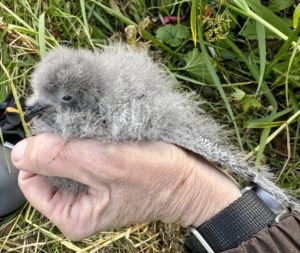By Karyn Murphy, Homer Friends member and Alaska Maritime Refuge Liaison
During this past summer, I was given the opportunity to join with a biologist from the Alaska Maritime National Wildlife Refuge and a grad student from Oregon to go to the Barren Islands for several weeks to work and live at the East Amatuli Island field camp. The seabird rich, uninhabited Barren Islands are about 60 miles south of Homer where Cook Inlet flows into the Gulf of Alaska. Our focus would be three-fold: check productivity plots of Fork-tailed Storm Petrel burrows and measure any chicks found; set up mist nets to capture petrels as they returned at night to feed their chicks and to collect the puke they regurgitated upon capture for later analysis; and setting up timelapse camera gear to monitor puffin colonies. 
Fork-tailed Storm Petrel chicks are cute fluffballs! We recorded wing length, weight and amount of down all of which helps approximate age of the chick.
The data we gathered contributed to decades long records which indicate not just how well the refuge’s trust species are doing but also what the birds’ health has to say about the health of the ocean they feed from. Weather was very stormy and windy with a few lovely sunny days. The icing on the cake was getting picked up by the refuge research ship the R/V Tiglax for our return to Homer. What a challenging and rewarding opportunity! So grateful to have had this time at the East Amatuli Island field camp. I hope others are inspired to volunteer for opportunities within our Alaska national wildlife refuge system! 
I’m not laying down on the job here. We were often up to our armpits reaching to the very back of the storm petrel burrows to find and gently extract the chick for measurements.
